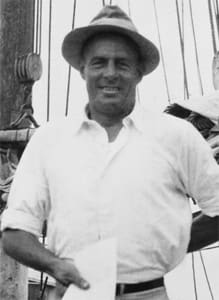If you had a boat, a bit of larceny in your heart, then the period of Prohibition in the United States (1921-33) must have seemed a dream come true. You bring the booze offshore and wait for your customers to show up. Cash only, thank you.
Law enforcement was a problem, but as the rum-runners stood off what was the three-mile territorial limit (now 12 miles), they were in international waters and could not be boarded by the Coast Guard. Small boats from the Jersey coast, Long Island, Brooklyn, or Manhattan would sneak past the Coast Guard to get to the waiting ships where they would buy the booze. It was a dangerous business.
The most famous of all the rum-runners was Bill McCoy. He sold his boatbuilding business in Florida to smuggle booze.
Less well-known was Alistair Moray, the nom-de-plume of a man who was supercargo aboard a 170-foot, four-masted schooner called Cask (that wasn’t really its name). Cask departed Glasgow, Scotland, with 20,000 cases of Dewar’s scotch, and a crew of malcontents for a winter passage to Rum Row, off the coast of New York. Moray published a book in 1929 describing his 11 months as supercargo aboard Cask.
For this adventure, Moray took along “a Wheatstone concertina, which [he] knew nothing about. [He] added [his] bagpipes which [he] knew a little about and a small library which included Capt. Lecky’s Wrinkles in Practical Navigation.”
The object of the voyage was to deliver 20,000 cases to the anchorage outside of New York Harbor so that the scotch could be sold and then the ship could return to Scotland for another load. Besides the usual hazards of a late fall trans-Atlantic passage, the cargo was constantly under siege by a thirsty crew. The ship itself might not have been the best vehicle for the job. The engine, the standing rigging, and the sails were more than a little tired before the voyage began. Cask was 390 tons, 170 feet long, with a 33-foot beam, drawing 12.5 feet. Unfortunately for the crew, the vessel was flat-bottomed with no keel, so her leeway was enormous — practically four points with a beam wind (about 45°).
Navigation aboard Cask relied on celestial and something called “the seagull instinct.” The seagull instinct was explained to Moray on a winter passage from New York to Bermuda. They had no sun sights of any value, but Moray wrote that the captain thought they weren’t many miles off Bermuda: “At 8 pm the mate sighted Gibbs Hill Light from the masthead.” “My first captain,” Moray relates, “had told me on several occasions he had known men who had what he called ‘seagull instinct.’ I realized what he meant, for since leaving the American coast we hadn’t had a sight of the sun in five days yet here we are striking a small group of islands 700 miles away to within an hour or two of when the captain predicted.”
Let’s do a noon sight aboard Cask, approaching New York on Dec. 10. We’ll be using the 2014 Nautical Almanac. The DR is 39°, 27 minutes north by 68°, 15 minutes west. The height of eye is 15 feet and the sextant altitude (Hs) is 27°, 25.4 minutes.
A. What is the time of local apparent noon?
B. What is the Ho?
C. What is the latitude?
Answers:
A. LAN in GMT is 1626.
B. Ho is 27°, 36 minutes.
C. Latitude is 39°, 27 minutes north.

